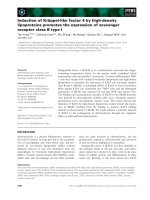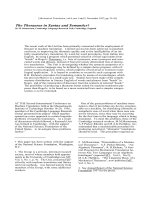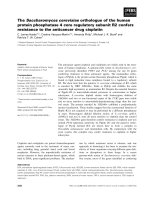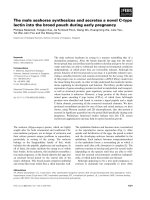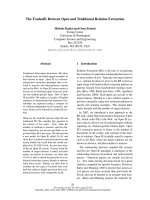Báo cáo khoa học: "The of 4 quality and wood properties provenances of South-African-grown" potx
Bạn đang xem bản rút gọn của tài liệu. Xem và tải ngay bản đầy đủ của tài liệu tại đây (736.24 KB, 10 trang )
Original
article
The
quality
and
wood
properties
of
4
provenances
of
South-African-grown
Pinus
tecunumanii
FS
Malan
Division
of
Forest
Science
and
Technology,
CSIR,
Box
395,
Pretoria,
South
Africa
(Received
1st
September
1992;
accepted
25
June
1993)
Summary —
The
wood
properties
of
4
provenances
of
South-African-grown
Pinus
tecunumanii
(ie
Yucul,
Camelias,
Mountain
Pine
Ridge
and
St
Rafael)
were
examined
and
compared
with
those
of
3
commercial
controls,
ie
Pinus
patula,
Pinus
elliottii
and
Pinus
taeda.
Trials
planted
at
2
sites
were
evaluated.
The
rate
of
growth
and
stem
form
of
the
4
P
tecunumanii
provenances
were
found
to
be
very
similar
to
that
of
the
3
controls
used
in
the
study,
but
crown
breaks
were
very
common,
probably
due
to
the
tendency
of
P
tecunumanii
to
develop
heavy
branch
whorls.
Tracheid
lengths
and
the
pattern
of
within-tree
variation
were
found
largely
similar
among
the
various
groups
of
trees
studied,
but
in
comparison
with
the
controls,
the
tracheid
cells of
P
tecunumanii
were
markedly
larger
in
cross-sectional
diameter
because
of
their
thicker
walls
and
larger
lumen
diameters.
However,
differences
in
the
proportion
of
cell-wall
material
among
the
groups
of
trees studied
were
small.
At
both
sites
the
annual
ring
structure
of
the
wood
of
P
tecunumanii
differed
pronouncedly
from
that
of
the
controls,
having
a
mean
latewood
percentage
of
only
about
half
of
that
of
P
patula
and
about
one-third
of
that
of
P
taeda
and
P
elliottii.
In
spite
of
the
large
relative
proportion
of
earlywood
characterising
the
wood
of
P
tecunumanii,
it
produces
wood
very
similar
in
density
to
that
of
P
patula
and
P
taeda
and
slightly
higher
than
that of
P
elliottii.
This
was
found
due
mainly
to
the
fact
that
the
broad
earlywood
zones
of
the
Pinus
tecunumanii
provenances
were
substantially
more
dense
than
those
of
the
commercial
controls
while
differences
in
latewood
densities
among
the
various
groups
considered
were
small
and
non-significant.
Apart
from
the
relatively
low
intra-
ring
varability
characterising
the
wood
of
P
tecunumanii,
all
provenances
of
this
species
were
found
to
be
less
variable
in
density
in
both
the
radial
and
axial
directions
in
the
stem,
compared
to
the
control
species.
The
higher
degree
of
uniformity
of
the
wood
produced
by
this
species
makes
it
a
very
promising
alternative
to
some
other
South-African-grown
pines,
especially
on
productive,
frost-
free
sites.
Pinus
tecunumanii
/
wood
density
/
tracheid
length
/
tracheid
cross-sectional
dimensions
/
ring
width
/ latewood
percentage
Résumé —
Les
qualités
et
propriétés
du
bois
de
4
provenances
de
Pinus
tecunumanii
d’Afrique
du
Sud.
Les
propriétés
du
bois
de
4
provenances
de
Pinus
tecunumanii
d’Afrique
du
Sud
(ie
Yucul,
Camelias,
Mountain
Pine
Ridge
et
Saint-Rafael)
ont
été
examinées
et
comparées
à
celles
de
3
standards
commerciaux,
ie
Pinus
patula,
Pinus
elliottii
et
Pinus
taeda.
Des
échantillons
prélevés
sur
2
sites
ont
été
étudiés.
Les
résultats
sont
présentés
dans
le
tableau
I.
Le
taux
de
croissance
et
la
forme
du
tronc
de
4
provenances
de
P
tecunumanii
se
sont
révélés
très
similaires
à
ceux
des
3
standards
commerciaux
(tableau
I)
mais
les
cassures
de
couronnes
étaient
très
fréquentes,
probablement
à
cause
de
la
tendance
du P
tecunumanii
à
développer
de
grosses
branches.
Les
longueurs
des
trachéides
et
la
forme
des
variations
intra-arbres
se
sont
révélées
largement
similaires
pour
les
divers
groupes
d’arbres
étudiés
mais,
par
rapport
aux
standards
commerciaux,
les
trachéides
des
P
tecunumanii
sont
notablement
plus
larges
en
diamètre
trans-
section
du
fait
de
leur
paroi
plus
large
et
du
diamètre
luminien
plus
important
(figs
5
et
6).
Cependant,
les
différences
de
proportions
de
leur
paroi
cellulaire
entre
les
groupes
d’arbres
étudiés
sont
apparues
faibles
(fig
7).
Sur
les 2
sites,
la
structure
du
cerne
annuel
du
bois
de
P
tecunumanii
diffère
sensiblement
de
celle
des
espèces
témoins ;
le
cerne
du
bois
de
P
tecunumanii
présente
une
proportion
de
bois
final
qui
équivaut
seulement
à
la
moitié
de
celle
du
P
patula
et
à
peu
près
à
1 tiers
de
celle
du
P
taeda
et
du
P
elliottii
(fig
2).
En
dépit
de
la
proportion
de
bois
initial
relativement
importante
qui
caractérise
le
bois
de
P
tecunumanii,
la
densité
du
bois
est
très
similaire
à
celle
du
P
patula
et
du P
taeda,
et
sensiblement
plus
élevées
que
celle
du
P
elliotti
(fig
3).
Cela
est
dû
prinicipalement
au
fait
que
les
zones
de
bois
initial
des
provenances
de
P
tecunumanii
sont
notablement
plus
denses
que
celles
des
espèces
témoins
alors
que
les
différences
pour
la
densité
du
bois
final
entre
les
différents
groupes
considérés
sont
faibles
et
non
significatives
(fig
4).
En
dehors
de
la
variation
intra-cerne
relativement
faible
qui
caractérise
le
bois
de
P
tecunumanii,
toutes
les
provenances
de
cette
espèce
se
sont
révélées
peu
différentes
en
densité
dans
les
directions
radiale
et
axiale
du
tronc
en
comparaison
des
espèces
témoins.
Le
degré
d’uniformité
plus
élevé
pour
le
bois
produit
par
cette
espèce
en
fait
une
alternative
très
prometteuse
par
rapport
aux
autres
pins
sud-africains,
spécialement
sur
les
sites
productifs
et
à
l’abri
des
dégâts
de
gelée.
Pinus
tecunumanii
/
longueur
trachéide
/
dimensions
trans-sectionnelles
trachéides
/
largeur
des
anneaux / pourcentage
de
bois
tardif
INTRODUCTION
Pinus
tecunumanii
occurs
naturally
in
Hon-
duras,
Guatemala,
El
Salvador
and
southern
Mexico.
It
is
one
of
8
species
of
the
sub-
section
Oocarpae
of
the
family
Pinaceae
although
the
taxonomic
status
of
the
taxon
is
uncertain
at
this
stage.
Other
commer-
cially
important
pine
species
belonging
to
this
subsection
are
P patula
and
P
oocarpa
(Dyer,
1989).
In
1973
P
oocarpa
provenance
trials
were
established
at
3
locations
in
South
Africa,
ie Tweefontein,
Wilgeboom
and
Kwambonambi
State
Forests,
as
part
of
an
international
provenance
testing
programme
under
the
auspices
of
the
Central
America
and
Mexico
Coniferous
Resources
Cooper-
ative
(CAMCORE).
Some
of
the
P
oocarpa
provenances
were
later
taxonomically
re-
classified
as
P
tecunumanii
(Dyer,
1989).
At
the
age
of
about
17
years
trees
from
2
of
the
trials
were
sampled
from
the
P
tecunumanii
plots
only
and
detailed
studies
carried
out
on
the
sawmilling,
pulp
and
paper
and
basic
wood
properties.
Included
in
these
trials
were
control
plots
of
the
commercial
species
P patula,
P
elliottii and
P
taeda.
The
control
plots
were
also
sampled
for
com-
parison
purposes.
Because
of
the
similarity
in
climatic
con-
ditions
between
South
Africa
and
Mexico,
the
former
has
always
looked
on
the
latter
as
an
important
area
for
the
selection
of
tree
species
of
potential
value.
P patula,
which
is
one
of
the
Mexican
pines,
is
today
by
far
one
of
the
most
important
commercial
pine
species
in
South
Africa,
comprising
about
44%
of
the
total
area
under
pine
plantations.
It
yields
a
serviceable
yellowish-white
wood,
which
is
comparatively
non-resinous
and
has
an
average
wood
density
of
about
0.450
g/cc
varying
from
about
0.350
to
0.610
g/cc
within
trees
(Poynton,
1979;
Birks
and
Barnes,
1991;
Wright
and
Malan,
1991).
P
elliottii
is
South
Africa’s
second-most
important
pine
species,
comprising
about
23%
of
the
total
area
under
pines.
It
wood
has
an
average
density
of
0.510
g/cc
vary-
ing
from
0.410
to
0.650
g/cc.
The
wood
is
more
resinous
than
P
patula
and
is
prone
to
the
formation
of
star-shaped
cracks
filled
with
resin
(Poynton,
1979).
P
taeda
comprises
about
9%
of
the
total
pine
plantation
area.
It
has
an
average
wood
density
of
0.480
g/cc
varying
from
0.370
to
0.620
g/cc.
Gilmore
and
Pearson
(1969)
and
Zobel
et al (1983)
(as
reported
by
Zobel
and
van
Buijtenen
(1989))
found
within-tree
variations
of
0.480
to
0.570
g/cc
and
0.320
to
0.550
g/cc,
respectively.
In
South
African
pines
the
large
degree
of
variation
of
wood
properties
within
trees
is
of
great
concern.
The
fast
growth
rate
of
South
African
pine
and
the
resulting
relatively
short
rotation
age,
cause
an
increased
proportion
of
juvenile
wood
and
consequently
a
high
degree
of
within-tree
variability
at
the
time
of
final
harvest.
For
this
reason
a
consider-
able
effort
was
made
to
examine
the
degree
and
patterns
of
variation
in
P
tecunumanii
in
great
detail
and
to
compare
them
with
those
in
existing
commercial
species.
This
paper
summarises
the
results
of
2
studies
and
are
based
on
CSIR
reports
sub-
mitted
by
Malan
and
Hoon
(1991 a,
b).
MATERIALS
AND
METHODS
Sampling
and
sample
preparation
Field
trials
are
situated
on
the
Tweefontein
and
Wilgeboom
State
Forests
in
the
eastern
Transvaal.
The
trials
consist
of
various
prove-
nances
of
P
oocarpa
and
P
tecunumanii
as
well
as
a
number
of
commercial
controls,
ie
P patula,
P
elliottii and
P
taeda.
The
experimental
lay-out
is
a
4
x
4
lattice
design
with
5
replications
and
25-
tree
square
experimental
plots.
At the
age
of
approximately
17
yr,
field
sam-
pling
was
carried
out
by
taking
2
representative
trees
from
each
P
tecunumanii
experimental
plot
as
well
as
from
the
control
plots,
giving
a
total
of
10
trees
to
represent
each
provenance
and
con-
trol.
Tree
data
collected
at
the
time
of
felling
included
diameter
at
breast
height,
total
tree
height,
height
to
the
first
branch
and
tree
lean.
The
latter
served
as
a
measure
of
butt
sweep.
Three
transverse
discs
per
height
level,
20
mm
thick,
were
cut
from
all
trees
at
0,
25,
50,
75
and
100%
height
level.
A
stem
diameter
of
80
mm,
which
is
the
minimum
top
diameter
for
pulpwood
logs,
was
taken
as
the
100%
height
level
for
the
purpose
of
this
study.
Two
of
these
discs
were
used
for
pulp
and
paper
studies
(Robertson,
1991)
and
the
third
for
carrying
out
basic
wood
property
studies,
such
as
air-dry
wood
density,
tracheid
length,
ring
width,
latewood
percentage,
spirality
and
the
cross-sectional
dimensions
of
tracheids.
The
sampling
strategy
followed
enabled
the
preparation
of
4,1
m
logs
for
a
comprehensive
sawmilling
and
timber
quality
study
(Marais,
1991).
Data
acquisition
Eccentricity,
ovality
and
taper
Disc
samples
were
subjected
to
image
analysis
to
determine
cross-sectional
area,
diameters
in
the
north-south
and
east-west
directions,
maximum
and
minimum
diameters,
the
maximum
and
min-
imum
radii,
and
the
form
factor
(4π
x
cross-sec-
tional
area/perimeter
2
).
In
the
latter,
a
value
of
1
suggests
a
perfect
circle
(Kontron
Electronics,
1989).
This
information
was
used
to
assess
the
degree
of
ovality,
eccentricity,
incidence
of
re-
action
wood
and
the
general
cross-sectional
shape
of
the
stem
at
various
height
levels
in
the
stem.
Wood
density
(unextracted)
In
the
case
of
the
Tweefontein
material,
every
third
ring,
beginning
with
ring
number
2
from
the
pith,
was
sampled
and
the
basic
densities
of
the
separated
rings
determined
using
the
saturated
moisture
content
method
described
by
Smith
(1954).
In
the
case
of
the
material
sampled
in
the
Wilgeboom
trial,
air-dry
densities
at
10%
mois-
ture
content
were
determined
by
means
of
a
gamma-ray
densitometer
that
had
just
come
into
operation
(Malan,
1991).
Mean
values
were
cal-
culated
for
each
ring
as
well
as
for
the
latewood
and
earlywood
zones
separately.
Two
radii
at
all
height
levels,
except
the
100%
height
level,
of
all
trees
were
studied.
In
order
to
allow
more
reliable
comparisons
between
the
2
sites,
the
basic
densities
deter-
mined
on
the
Tweefontein
material
were
converted
to
air-dry
density
at
10%
moisture
content.
Esti-
mates
of
the
amount
of
shrinkage
needed
to
con-
vert
basic
density
to
air-dry
density
were
obtained
from
tables
compiled
by van Vuuren
et al (1978).
Tracheid
length
Samples
for
tracheid
length
measurements
were
taken
at
every
third
ring,
starting
with
ring
number
2.
Specimens
for
maceration,
approximately
2-
mm
thick,
were
cut
across
the
entire
growth
ring
to
ensure
maceration
of
the
complete
ring.
These
were
macerated
in
a
50:50
mixture
of
glacial
acetic
acid
and
hydrogen
peroxide
(30%
vol)
for
3 d
at
60°C.
On
average,
about
50
tracheid
lengths
were
measured
per
ring
using
the
Video-
plan
option
of
the
Kontron
image
analysis
sys-
tem
(Kontron
Electronics,
1989).
Ring
width
and
latewood
percentage
All
radially
cut
strips
were
sanded
to
a
smooth
and
polished
finish
for
measuring
ring
and
late-
wood
widths.
Latewood
widths
were
measured
by
visually
assessing
the
boundary
between
early-
wood
and
latewood.
It
is
recognized
that
although
the
assessment
of
the
earlywood/latewood
bound-
ary
may
be
subject
to
variation
when
using
visual
assessment,
the
transition
from
earlywood
to
late-
wood
was
easy
to
distinguish
in
most
cases.
Grain
angle
In
all
samples
grain
angle
was
determined
in
the
earlywood
zone
of
every
third
ring
starting
from
ring
number
2
from
the
pith.
The
wood
was
split
along
the
grain
in
a
tangential
direction
and
mea-
sured
on
the
split
surface
to
the
nearest
degree.
The
angle
at
the
pith
was
taken
as
zero
and
used
as
a
reference
line.
All
measurements
further
away
were
corrected
accordingly.
Left-hand
angles
were
recorded
as negative
and
right-hand
angles
as
positive.
In
the
statistical
analysis
a
constant
of
20°
was
added
to
all
grain
angle
val-
ues
to
avoid
the
possibility
of
zero
means
and
very
large
coefficients
of
variation.
Cross-sectional
dimensions
of
tracheids
The
cross-sectional
dimensions,
lumen
diame-
ter
and
double-wall
thickness
of
tracheids,
were
measured
in
both
the
earlywood
and
latewood
zones
on
highly
polished
transverse
surfaces
fol-
lowing
a
technique
based
on
that
developed
by
Lantican
(1972).
A
thin
layer
of
microscope
slide
mounting
medium
was
applied
to
the
polished
surface
to
enhance
the
images
of
the
cells.
Mea-
surements
were
taken
both
in
the
radial
and
tan-
gential
directions
of
the
tracheids
using
the
video-
plan option
of
the
Kontron
Image
Analysis
system
(Kontron
Electronics,
1989).
The
mean
amount
of
cell-wall
material
in
rela-
tion
to
the
voids
(fractional
wall
volume)
for
each
group
was
estimated
using
calculations
based
on
the
wall
thickness,
lumen
diameter
and
the
proportion
of
latewood.
Tracheid
cross-sectional
properties
were
studied
on
material
from
the
Tweefontein
site
only.
Statistical
analyses
Statistical
analyses
were
performed
to
test
dif-
ferences
among
groups,
the
effect
of
age
and
height
in
tree
and
their
interactions.
A
mixed
lin-
ear
model
was
assumed
in
this
study,
in
which
the
effects
of
heights
and
rings
and
their
interac-
tion
are
all
fixed,
and
those
of
proven-
ances/species,
trees
and
radii
and
all
other
inter-
actions
are
random.
Orthogonality
was
obtained
by
rejecting
data
from
the
outer
rings
in
the
lower
discs
as
well
as
the
2
top
discs,
utilising
the
inner
8-11
rings
which
were
represented
by
3-4
sam-
pling
positions,
respectively.
Regression
equations
based
on
a
full
set
of
data
from
each
provenance/species
were
devel-
oped
for
each
property,
using
several
models,
which
include
all
linear
and
quadratic
effects
of
ring
number
and
percentage
height
above
ground
level
and
their
interactions.
The
forward
selec-
tion
procedure
of
multiple
stepwise
regression
analysis
was
used.
Due
to
the
lack
of
space
the
statistical
results
are
not
presented
in
this
document.
Full
details
can
be
obtained
from
the
various
reports
that
were
submitted
(Malan
and
Hoon,
1991a,b;
Robertson,
1991
and
Marais,
1991).
RESULTS
AND
DISCUSSION
The
results
are
summarised
in
table
I.
For
the
sake
of
simplicity,
the
3
control
species
and
4
provenances
of
P
tecunumanii
con-
in
this
study
will
be
referred
to
as
’groups’
in
the
rest
of
the
text.
Eccentricity,
ovality
and
taper
Differences
in
mean
ovality
(ratio
of
maxi-
mum
and
minimum
diameters)
within
indi-
vidual
trees,
between
trees
of
the
same
species,
and
between
groups,
were
small
and
non-significant.
Statistically
significant
differences
in
the
degree
of
eccentricity
(ratio
of
maximum
and
minimum
radii)
were
found
among
the
various
groups
but
these
differences
were
too
small
to
be
of
any
practical
significance.
In
general
P
tecunumanii tended
to
be
more
eccentric
than
the
species
used
as
controls,
probably
due
to
the
fact
that
the
control
species
were
genetically
improved.
As
expected
the
degree
of
eccentricity
decreased
with
increasing
height.
No
sta-
tistical
significant
interaction
between
groups
and
height
level
could
be
detected,
which
is
an
indication
that
the
pattern
of
change
with
height
does
not
vary
from
group
to
group.
The
taper
and
cross-sectional
form
factor
did
not
differ
among
the
groups
and
was
found
almost
constant
at
a
mean
of
0.82.
Ring
structure
Ring
width
decreased
significantly
with
age
but
no
significant
difference
in
ring
width
could
be
found
among
the
groups
of
trees
studied
(fig
1),
which
is
a
clear
indication
that
the
various
groups
of
trees
maintained
approximately
similar
rates
of
growth.
Latewood
percentage
was
markedly
lower
in
P
tecunumanii with
values
varying
from
10
to
12%
compared
with
20%
in
P
patula
and
about
31
%
P
taeda
and
P
elliot-
tii
(fig
2).
From
figure
2
it
is
also
clear
that
the
radial
patterns
of
variation
in
latewood
per-
centage
are
virtually
the
same
in
the
4
P
tecunumanii
provenances
showing
as
very
gradual
increases
from
pith
to
bark.
This
is
in
sharp
contrast
to
the
control
species
where
rapid
increases
in
latewood
percent-
ages
occurred.
This
explains
to
a
large
extent the
more
rapid
increases
in
pith-to-
bark
density
that
were
observed
in
the
con-
trol
species.
This
will
be
discussed
further
in
the
next
section.
Wood
density
Density
increased
with
age
in
all
groups
but
results
of
the
analyses
of
variation
indicated
a
highly
significant
ring
x
species
interac-
tion
suggesting
that
the
pith-to-bark
density
gradients
differ
among
the
5
groups
of
trees.
Results
of
a
2-way
classification
used
to
examine
the
interactions
are
depicted
in
fig-
ure
3.
From
these
graphs
it
is
clear
that
the
wood
density
across
the
radius
is
remark-
ably
more
uniform
in
the
P
tecunumanii
provenances
than
in
the
control
groups.
Wood
density
decreased
rapidly
and
sig-
nificantly
with
height
in
tree
due
to
the
increase
in
the
proportion
of
juvenile
wood.
No
among-group
differences
in
the
pattern
of
variation
with
respect
to
height
in
tree
could
be
detected.
In
spite
of
the
low
latewood
percentage
that
characterised
the
wood
of
all
P
tecunumanii
provenances,
this
species
pro-
duced
wood
of
about
the
same
density
as
those
of
P patula
and
P
taeda.
In
the
case
of
the
Wilgeboom
material
the
wood
densities
of
the
4
P
tecunumanii
provenances
were
significantly
higher
than
that
of
the
P
elliot-
tii
control,
in
spite
of
the
fact
that
the
latter
species
exhibited
a
mean
latewood
per-
centage
of
almost
3
times
that
of
P
tecunumanii
(table
I,
fig
2).
A
comparative
study
of
the
earlywood
and
latewood
densities
of
the
various
groups
involved
explains
the
reason
for
this.
Results
indicated
no
significant
differences
in
late-
wood
density
among
the
5
groups
but
the
densities
of
the
broad
earlywood
zones
of
P
tecunumanii were
considerably
higher
(fig
4).
No
site
effects
on
the
wood
density
of
P
tecunumanii
could
be
detected.
Tracheid
length
In
all
species
tracheid
lengths
increased
rapidly
with
age,
especially
in
the
first
8-11
yr,
slowing
off
towards
the
outer
rings.
With
respect
to
height
in
tree,
tracheid
lengths
increased
rapidly
from
ground
level
to
25%
height,
followed
by
a
decrease.
Although
differences
observed
in
tracheid
length
could
not
be
proven
statistically,
the
P
tecunumanii from
both
sites
produced
tra-
cheids
of
slightly
longer
length
than
the
con-
trols
at
all
height
levels.
Furthermore,
the
P
tecunumanii from
the
Wilgeboom
site
pro-
duced
tracheids
that
were
substantially
longer,
suggesting
some
site
effect,
but
a
larger
number
of
trees
per
species
needs
to
be
examined
before
reliable
deductions
can
be
made
in
this
regard.
Tracheid
cross
dimensions
In
the
technology
of
pulp
and
paper
making,
there
is
increasing
evidence
that
tracheid
cross-sectional
dimensions
influence
paper
properties
more
than
tracheid
length
(Hay-
green
and
Bowyer,
1989).
Marked
differences
among
the
groups
of
trees
studied
were
found
for
almost
all
of
the
cross-sectional
dimensions
examined.
Both
tracheid
wall
thickness
and
lumen
diameter
of
P
tecunumanii wood
exceeded
those
of
P patula
and
P
taeda
(fig
5),
result-
ing
in
tracheids
that
were
generally
larger
in
diameter
in
P
tecunumanii
(fig
6).
Small
differences
in
the
mean
fractional
wall
volume
of
the
wood
were
among
the
5
groups
of
trees
studied
(fig
7).
Calculated
values
varied
in
a
very
close
range
of
0.28
to
0.32
explaining
the
small
density
differ-
ences
observed
among
the
5
groups
of
trees
obtained
from
the
Tweefontein
trial.
Wood
density
is
normally
a
good
measure
of
the
amount
of
cell-wall
material
in
relation
to
the
voids
in
the
wood.
Spiral
grain
No
significant
effect
of
species,
trees
within
species,
height
in
tree,
age
and
any
of
the
interaction
terms
could
be
detected.
On
average
the
degree
of
grain
deviation
appeared
to
be
higher
in
P patula,
but
sta-
tistically
this
did
not
prove
significant.
The
degree
of
grain
deviation
from
the
vertical
varied
considerably
from
ring
to
ring
but
no
particular
tendency
could
be
observed.
In
other
words,
grain
never
spiralled
in
any
one
direction
to
cause
spiral
grain
in
the
tree.
CONCLUSIONS
Due
to
the
relatively
low
number
of
trees
per
species
used
in
this
study,
the
mean
values
obtained
should
be
regarded
with
some
caution.
Statistically
the
differences
between
the
4
P
tecunumanii
provenances
could
not
be
substantiated,
but
in
general,
the
differences
between
the
4
provenances
were
small
and
probably
of
little
practical
significance.
However,
as
species
P
tecunumanii
exhibited
some
important
and
significant
differences
from
the
3
commercial
species
used
as
controls.
Compared
to
the
commercial
controls,
P
tecunumanii
was
found
to
be
largely
simi-
lar
as
far
as
rate
of
growth
and
the
cross-
sectional
shape
of
the
stems
are
concerned.
In
general,
P
tecunumanii
produced
wood
of
similar
or
slightly
higher
density
than
that
of
the
control
species,
but
more
importantly,
the
wood
of
all
the
P
tecunumanii
prove-
nances
was
less
variable
in
density
both
within
and
between
annual
rings.
Tracheid
lengths
did
not
differ
statisti-
cally
between
the
5
groups
of
trees
stud-
ied,
but
judging
from
the
mean
values
obtained,
the
P
tecunumanii
provenances
produced
wood
of
slightly
longer
tracheid
lengths.
Variation
patterns
in
the
radial
and
axial
direction
were
largely
similar
among
the
5
groups.
In
P
tecunumanii tracheid
cells
were
markedly
larger
in
cross-sectional
diameter
since
the
walls
were
thicker
and
the
lumens
larger
in
diameter.
Although
the
average
wood
properties
in
conifers
are
important,
the
difference
between
earlywood
and
latewood
is
often
striking
and
can
have
an
important
effect
on
end-use
characteristics.
Differences
in
latewood
percentage
among
the
P
tecunumanii
provenances
were
small
but
their
latewood
percentages
differed
markedly
from
those
of
the
controls.
In
spite
of
the
large
percentage
of
early-
wood
and
differences
in
cross-sectional
dimensions
of
tracheid
cells
that
charac-
terised
the
wood
of
P
tecunumanii,
all
prove-
nances
of
this
species
produce
wood
of
an
acceptable
density,
mainly
due
to
the
fact
that
the
proportion
of
cell-wall
material
is
not
altered
to
any
significant
degree.
Furthermore,
the
latewood
density
was
virtually
similar
among
the
groups
studied
but
the
earlywood
produced
by
P
tecunumanii
was
substantially
higher
in
den-
sity,
resulting
in
more
uniformity
within
rings.
Thus,
the
wood
of
P
tecunumanii
is
less
variable
in
density
and
it
can
expected
that
the
timber
will
also
be
more
uniform
in
the
properties
related
to
wood
density.
As
indicated
earlier,
the
large
degree
of
variation
of
wood
properties
within
South
African
pines
as
a
result of
the
large
juvenile
core
at
the
time
of
final
harvest,
is
of
great
concern.
This
species
has
proved
to
be
a
good
performer
on
productive,
frost-free
sites.
In
view
of
the
higher
degree
of
within-tree
uni-
formity
of
the
wood
produced
by
this
species,
compared
with
that
of
existing
com-
mercial
species,
this
species
can
be
a
very
promising
alternative
to
some
of
the
other
South-African-grown
pines
in
future,
pro-
vided
the
problem
of
the
high
incidence
of
crown
breakage
can
be
solved.
ACKNOWLEDGMENTS
The
author
wishes
to
thank
the
CSIR
executive
and
the
South
African
Forestry
Corporation
Lim-
ited
(SAFCOL)
who
sponsored
the
investigations,
the
staff
of
the
Sabie
Forestry
Research
Centre
for
their
assistance
during
field
sampling,
and
I
Bruwer
of
the
Division
of
Information
Services
of
the
CSIR
for
editing
this
document.
REFERENCES
Birks
JS,
Barnes
RD
(1991)
Genetic
control
of
wood
density
in
Pinus
patula.
ODA
Research
Scheme
R4616,
Oxford
Forestry
Institute,
Oxford
University,
29
pp
Dyer
ST
(1989)
A
numerical
taxonomic
study
of
the
closed
cone
pines
(Pinus
subsection
Oocarpae)
based
on
needle
anatomy.
MSc
Thesis,
Department
of
Botany,
University
of
Pretoria
Haygreen
JG,
Bowyer
JL
(1989)
Forest
Products
and
Wood
Science
2nd
Edition,
Iowa
State
University
Press,
Ames.
Kontron
Electronics
(1989)
Image
analysis
sys-
tems:
VIDAS
User’s
manual,
rel
2.0.
Kontron
Bildanalyse
GMBH,
Eching,
Germany
Lantican
CB
(1972)
Variations
in
some
structural
features
and
wood
properties
of
Pinus
caribeae
Morelet
from
British
Honduras.
Unpublished
D
Phil
thesis,
University
of
Oxford
Malan
FS
(1991)
Direct
gamma
ray
densitometric
system
for
wood.
CSIR
Special
Report,
FOR-
I 158, 15
pp
Malan
FS,
Hoon
M
(1991a)
The
wood
properties
of
Pinus
tecunumanii from
Tweefontein
State
For-
est.
CSIR
Special
Report
FOR-I
146,
58
pp
Malan
FS,
Hoon
M
(1991 b)
The
wood
properties
of
Pinus
tecunumanii from
two
locations
in
the
Eastern
Transvaal.
CSIR
Special
Report
FOR-
I 162, 23 pp
Marais
IP
(1991)
The
sawmilling
properties
of
three
Pinus
tecunumanii
provenances
from
Tweefontein
State
Forest.
CSIR
Special
Report
FOR-I
162,
31
pp
Poynton
RJ
(1979)
Tree
Planting
in
Southern
Africa
Vol.
1:
The
Pines.
Department
of
Forestry,
South
Africa,
576
pp
Robertson
PE
(1991)
The
pulping
characteris-
tics
of
Pinus
tecunumanii,
P
patula
and
P
taeda.
CSIR
Special
Report
FOR-I
83, 17
pp
Smith
DM
(1954)
Maximum
moisture
content
method
for
determining
specific
gravity
of
small
wood
samples.
US
Department
of
Agriculture,
Forest
Products
Laboratory,
Rept 2014
van
Vuuren,
NJJ,
Banks
CH,
Stöhr
HP
(1976)
Shrinkage
and
density
of
timbers
used
in
the
Republic
of
South
Africa.
Bulletin
57,
Dept.
of
Water
Affairs
and
Forestry
Wright
JA,
Malan
FS
(1991)
Variation
in
wood
and
tracheid
properties
of
Pinus
pseu-
dostrobus,
P
maximinoi
and
P
patula.
IAWA
bulletin,
12, 465-467
Zobel
BJ,
van
Buijtenen
JP
(1989)
Wood
Varia-
tion.
Its
Causes
and
Control.
Springer-Verlag,
Berlin

